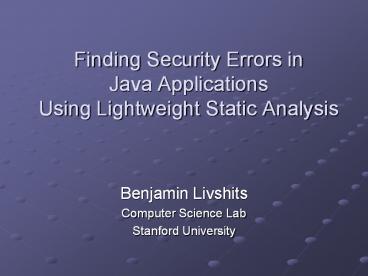Finding Security Errors in Java Applications Using Lightweight Static Analysis - PowerPoint PPT Presentation
Title:
Finding Security Errors in Java Applications Using Lightweight Static Analysis
Description:
Created user-friendly code analysis tools. Based on Eclipse, an open-source Java IDE ... Can be used by the malicious user to. read unauthorized info, delete ... – PowerPoint PPT presentation
Number of Views:123
Avg rating:3.0/5.0
Title: Finding Security Errors in Java Applications Using Lightweight Static Analysis
1
Finding Security Errors in Java Applications
Using Lightweight Static Analysis
- Benjamin Livshits
- Computer Science Lab
- Stanford University
2
Vulnerability Research Focus
- Static analysis for vulnerability detection
- Until recently, a large portion of server-side
software was written in C/C - Vulnerabilities come from poor language and API
design - Buffer overruns
- Format string violations
- More profound
- Time-of-check-time-of-use errors (TOCTOU)
3
Security Errors in Java are Emerging
- Situation is changing
- More and more Web-based applications are written
in Java - Web-based applications are good vulnerability
targets - New categories of errors in this domain
SQL Injections
HTTP response splitting
Cross-site scripting
LDAP injection
Forceful browsing
Bad session stores
4
Finding Errors with Static Analysis
- Our approach
- Static Analysis has been proven useful for
finding security errors in C programs - Apply to Java to find new categories of errors
- What we did
- Created user-friendly code analysis tools
- Based on Eclipse, an open-source Java IDE
- Easy to run on your own code
- Focused on two types of errors so far
- Bad session stores
- SQL injections
- We look at these two error patterns next
5
Focus on Two Error Patterns
Bad session store
SQL injection
- Object o
- HttpSession s
- s.setAttribute(name, o)
String query request.getParameter(name) java.
sql.Statement stmt stmt.executeQuery(query)
- A common pattern in servlets leading to errors
- HttpSessions need to be saved to disk
- Object o must implement java.io.Serializable
- Bad API design
- Can lead to crashes and DOS attacks
- Unchecked input passed to backend database
- Carefully crafted input containing SQL will be
interpreted by database - Can be used by the malicious user to
- read unauthorized info,
- delete data,
- even execute commands,
- etc.
6
Our Tools
Bad session stores
SQL Injections
- Identify all sources of user information
- Identify all sinks where sensitive data can flow
- Filter out sinks that take constant strings
- Help to follow data from sources to sinks
- Report errors
- Look at the type of the 2nd argument of
setAttribute - setAttribute(, expr)
- Do a type check for expr that dont implement
java.io.Serializable - Report errors
7
Screen shot
Error in the source
Potential Error
8
Benchmarks
- 10 Web-based applications
- Widely deployed and vulnerable to attacks
- Most blogging tools
- Quite large 10s of KLOC
- Rely on very large J2EE libs
9
Results for Bad Session Stores
- Found 14 errors
- 8 false posititives
- 37 false pos rate
- Why false positives?
- Declared types are too wide
- Can improve with better type info from pointer
analysis
10
Results for SQL Injections
- Found 6 errors
- Can find low-hanging errors
- Easy when sources and sinks are close
- Often they are very far apart
- Many require more elaborate analysis
11
Summary
- Created lightweight interactive tools for finding
security errors in Java - Found a total of 20 errors
- However, there are
- false positives and
- unknowns potential errors our tools cant
address - Conclusion
- Our tools are good for finding simpler errors
- Hard errors often require a stronger analysis of
data propagation - Working on a pointer analysis-based approach































